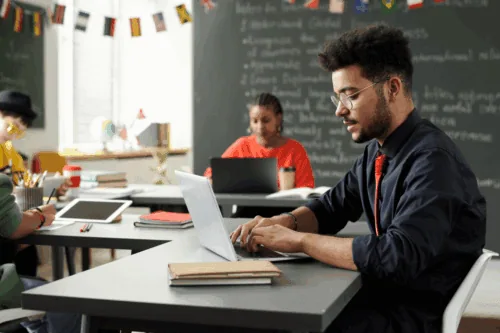Welcome to an enlightening journey through the realm of culturally responsive teaching. In today’s diverse classroom settings, understanding and implementing culturally responsive teaching methods is not just beneficial—it’s essential. This guide is crafted to illuminate the path for educators, entry-level job seekers in the education sector, and all stakeholders interested in creating inclusive, engaging, and effective learning environments.
As classrooms continue to diversify, the need for teaching methods that resonate with every student’s cultural background becomes increasingly crucial. This guide will explore the what, why, and how of culturally responsive teaching, providing the necessary tools and insights to make a meaningful impact in your educational practices or career pursuits.
Let’s dive into the transformative world of culturally responsive teaching, where every lesson is an opportunity to connect, understand, and empower. Ready to explore how you can make a difference in the educational landscape? Read on.
Understanding Culturally Responsive Teaching
What is culturally responsive teaching? At its core, it’s an educational approach that respects and incorporates the cultural backgrounds of all students into all aspects of learning. This method goes beyond merely tolerating cultural differences to actively engaging students’ cultural references in the teaching process.
Core Concepts of Culturally Responsive Teaching
Culturally responsive teaching is built on a foundation of understanding and responsiveness. Here are some of the central concepts that define this method:
- Inclusivity: Creating a learning environment where all students feel respected and connected.
- Cultural Competence: Enabling educators to interact effectively with individuals from diverse cultural backgrounds.
- Dynamic Teaching: Adapting teaching methods to fit students’ diverse learning styles and cultural perspectives.
Why It Matters
Culturally responsive teaching is crucial as classrooms around the nation become increasingly diverse. It not only helps in closing the achievement gap but also prepares students for a globalized world. Effective culturally responsive teaching can lead to the following positives:
- Improved academic outcomes by making learning relevant to all students.
- Enhanced student confidence and engagement by valuing their cultural backgrounds within the educational framework.
- Better relationships between teachers and students, enabling a sense of belonging and cooperation.
Key Statistics
Research backs the benefits of culturally responsive teaching:
- Studies show that students perform better academically when they feel their culture is recognized and valued.
- According to an American Educational Research Association report, schools that focus on cultural inclusivity have fewer behavioral problems and higher graduation rates.
Embracing culturally responsive teaching is about improving educational outcomes and building a more equitable and just society.
Principles of Culturally Responsive Teaching
Implementing culturally responsive teaching involves several vital principles that educators can adopt to ensure their approach is practical and respectful of all students.
Recognition of Cultural Heritage
One foundational principle is acknowledging and valuing students’ cultural heritage as assets in the classroom. This practice not only affirms the identity of students but also enriches everyone’s learning experience. Initiatives could include:
- Integrating literature, examples, and case studies from diverse cultures.
- Encouraging students to share their cultural practices and perspectives.
Student-Centered Learning
Putting students at the center of their learning process is crucial. Tools for this include:
- Adapting teaching styles to suit various cultural learning preferences.
- Allowing students to express their thoughts and answer questions through the lens of their cultural perspectives.
Empowering Language Choices
The language used in classrooms can empower or disenfranchise students. Teachers should:
- Use inclusive language that respects all cultural backgrounds.
- Avoid stereotypical or biased expressions that may alienate or offend students.
These principles ensure that all students see themselves reflected in their education and feel they are active, valued participants in their learning journey.
Further Resources
For additional insights into the practical application of these principles, educators can explore more on promoting equity in classroom settings, which is accessible at Learning for Justice.
This nurturing of diverse educational frameworks aligns with our perpetual mission. To explore related methods further, read about inclusive education strategies and their significance in modern curriculums.
Benefits of Culturally Responsive Teaching in Modern Classrooms
Culturally responsive teaching offers profound benefits that significantly enhance the educational environment and student outcomes.
Boosts Academic Success
Adapting teachings to fit cultural contexts can improve academic performance. Students understand better when taught through familiar cultural lenses.
- Enhances comprehension and retention.
- Promotes active participation and engagement in learning.
Strengthens Social Connections
Schools that implement culturally responsive strategies often observe improved relationships, not just among students but also between students and teachers.
- Reduces feelings of isolation among minority students.
- Builds trust and a supportive community atmosphere.
Fosters Inclusion and Equity
By respecting and including diverse cultural backgrounds, education becomes more inclusive. This approach naturally promotes equity within the school system.
- It makes every student feel valued and understood.
- Challenges and diminishes biases and stereotypes.
The inclusive nature of culturally responsive teaching helps nurture a learning environment where diversity is celebrated and leveraged for greater understanding and cooperation. For more information on building inclusive educational environments, educators can refer to resources such as Edutopia’s guide on culturally responsive teaching.
Challenges and Solutions in Implementing Culturally Responsive Teaching
While the benefits of culturally responsive teaching are vast, educators often encounter several challenges when trying to implement these strategies effectively.
Facing Resistance
Resistance can come from various sources, including school administrations, parents, or teachers.
- Solution: Provide training and workshops to educate all stakeholders about the value and methods of culturally responsive teaching.
Limited Resources
Schools might lack the materials and resources to implement culturally responsive strategies effectively.
- Solution: Seek grants, partnerships, and community support to build resource networks.
Adapting Existing Curriculums
Incorporating new teaching methods into existing curriculums can be daunting and labor-intensive.
- Solution: Start small by integrating culturally relevant materials into lesson plans and gradually expand as comfort and resources grow.
Misunderstandings About Cultural Relevance
There can be misconceptions about culturally responsive teaching, leading to superficial or ineffective practices.
- Solution: Regular professional development and sharing best practice case studies can help clarify and expose this approach’s deep roots and impacts.
Overcoming these challenges ensures that all students benefit from a truly inclusive and equitable educational experience. For insights on obtaining resources and training materials, educators can explore the U.S. Department of Education’s resources.
How to Design a Culturally Responsive Curriculum
Designing a culturally responsive curriculum is critical to fostering an inclusive educational environment. Here, we explore how educators can create curricula that reflect and respect diverse cultural backgrounds.
Assess the Current Curriculum
Begin by evaluating the existing curriculum.
- Identify areas lacking in cultural diversity and inclusivity.
- Survey students and teachers for feedback on cultural representation.
Incorporate Diverse Perspectives
Integrate a wide range of cultural perspectives into all subjects.
- Use diverse authors and historical accounts in lessons.
- Include case studies and examples from various cultures.
Engage with Local Communities
Collaborating with local communities enhances relevance and authenticity.
- Invite guest speakers from different cultural backgrounds.
- Organize field trips to local cultural sites.
Train Staff Continuously
Professional development is crucial to keep teaching practices up-to-date.
- Hold regular training sessions on culturally responsive teaching strategies.
- Encourage staff to share experiences and solutions for challenges faced.
This curriculum design enriches learning and prepares students to thrive in a global society. For more tools and resources supporting the shift towards inclusivity, explore how teachers adapt curriculums to better reflect diverse student bodies.
Techniques for Effective Culturally Responsive Teaching
Effective culturally responsive teaching requires specific techniques that resonate with diverse student backgrounds, enhancing learning and engagement.
Active Listening and Response
Teachers need to listen to students’ cultural expressions and respond positively actively.
- Show genuine interest and encourage students to share their traditions and experiences.
- Adapt lessons to include students’ cultural contributions actively.
Use of Multimedia
Incorporating diverse multimedia resources can help bridge cultural gaps.
- Include videos, music, and art from various cultures in lessons.
- Utilize technology to connect students with diverse educational content.
Creating a Culturally Inclusive Classroom Environment
The physical and emotional environment should reflect cultural diversity and inclusion.
- Decorate the classroom with artifacts and symbols representing various cultures.
- Establish a classroom culture that celebrates diversity and promotes respect.
Collaborative Learning Projects
Projects that promote group work among students from different backgrounds promote understanding and appreciation for diversity.
- Design projects that require collaboration on culturally relevant topics.
- Facilitate discussions that allow students to express diverse perspectives.
By adopting these techniques, educators can create an environment where culturally responsive teaching thrives, making education a reflective, inclusive, and dynamic experience.
For practical examples and further reading on implementing these techniques, educators can examine resources at Harvard’s Project Zero, which offers tools for designing culturally mindful learning experiences.
FAQs
Here are some frequently asked questions about culturally responsive teaching to help clarify this approach.
What makes teaching culturally responsive?
Culturally responsive teaching involves recognizing, respecting, and using students’ identities and backgrounds as meaningful sources for learning.
How can teachers develop culturally responsive teaching strategies?
Teachers can develop their strategies by training, ongoing professional development, and actively engaging with diverse cultures within their community.
What are the first steps toward implementing culturally responsive teaching?
- Review the existing curriculum to identify cultural representation gaps.
- Engage with students and parents to understand their cultural perspectives.
Can culturally responsive teaching improve standardized test scores?
By making learning more relevant and engaging, students often show improved academic performance, including on standardized tests.
Is culturally responsive teaching only for language arts and social studies?
This approach applies to all subjects by incorporating diverse cultural viewpoints to enrich STEM, arts, and other curriculums.
Conclusion
Culturally responsive teaching enhances educational outcomes and fosters a nurturing environment where every student feels valued and understood. It recognizes the importance of integrating students’ cultural backgrounds into learning processes, promoting inclusivity and diversity. This educational approach prepares students to operate successfully in a globally interconnected world and contributes to a more equitable society.
Take Action
To truly make a difference, educators, administrators, and all stakeholders in education must actively adopt and promote culturally responsive teaching strategies. We encourage you to join efforts by engaging with platforms advocating diversity and inclusion positions in the education sector.
Join Diversity Employment today to connect with a network that supports inclusive education practices. Together, we can transform educational environments to embrace and celebrate our communities’ rich diversity!




